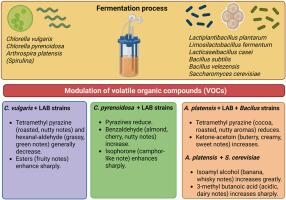普通小球藻和平节螺旋藻生物质发酵生产食品中具有感官吸引力的挥发性有机化合物的技术进展
IF 15.4
1区 农林科学
Q1 FOOD SCIENCE & TECHNOLOGY
引用次数: 0
摘要
微藻生物质是一种很有前途的原料,可用于可持续生产各种食品用挥发性有机化合物(VOCs)。微藻衍生的食品可能面临感官上的挑战,例如由于叶绿素或非典型气味而呈现强烈的绿色,以及消费者可能无法接受的“鱼腥味或草腥味”。改良或掩盖这些不良感官属性的发酵工艺的发展,或选择具有更中性感官特征的微藻菌株,都是创造新香气和口味的有趣选择。本文综述了目前微藻生物质发酵的研究现状,重点介绍了微藻小球藻(Chlorella vulgaris)和平台节旋藻(Arthrospira platensis)以及乳酸菌(LAB)、芽孢杆菌(Bacillus spp.)和酵母(Saccharomyces cerevisiae),它们是合成挥发性有机化合物发酵过程中最常见的微生物,具有独特的感官特征。主要发现和结论:小球藻与LAB菌株的发酵可以有效地减少吡嗪类和醛类(己醛),同时增加酯化化合物。节肢螺与乳酸菌或芽孢杆菌的发酵也降低了吡嗪(烤坚果香气)和呋喃(甜味、绿色香气),而酮-乙酰酮(与黄油和奶油香气相关)增加。酵母被发现负责酒精发酵和在发酵的platensis生物量中产生高级醇和酯类。综上所述,微藻生物质发酵是一种很有前途的生物技术策略,可以调节或改变微藻的VOC特征,有助于减少其强烈的风味和颜色特征。本文章由计算机程序翻译,如有差异,请以英文原文为准。

Technological advances in fermentation of Chlorella vulgaris and Arthrospira platensis biomass for production of volatile organic compounds with sensorial appeal in foods
Background
Microalgae biomass represents a promising feedstock for the sustainable production of a wide range of volatile organic compounds (VOCs) for food applications. Microalgae-derived food products may face sensory challenges, such as intense green colors due to chlorophyll or atypical odors and flavors ‘fishy or grassy’ that may not be well accepted by consumers. The development of fermentation processes that modify or mask these undesirable sensory attributes, or the selection of microalgae strains with more neutral sensory profiles are an interesting option to create new aroma and flavors.
Scope and approach
This review discusses current research on microalgae biomass fermentation, with special attention to the microalgae Chlorella vulgaris and Arthrospira platensis and lactic acid bacteria (LAB), Bacillus spp. and yeasts (Saccharomyces cerevisiae), which represent the most common microorganisms studied in fermentation process for synthesis of VOCs with unique sensory profile.
Key findings and conclusions
Fermentation of Chlorella with LAB strains demonstrated to be effective process to reduce pyrazines and aldehydes (hexanal), while esterified compounds increased. Fermentation of Arthrospira with LAB or Bacillus also reduced pyrazine (roasted nut aroma) and furans (sweet, green aroma), while an increase of ketone-acetoin associated with buttery and creamy aromatic notes was observed. Yeasts found to be responsible for alcoholic fermentation and the production of higher alcohols and esters in fermented A. platensis biomass. In sum, the fermentation of microalgae biomass is a promising biotechnological strategy to modulate or transform the VOC profile of microalgae, contributing to the reduction of their strong flavor and color features.
求助全文
通过发布文献求助,成功后即可免费获取论文全文。
去求助
来源期刊

Trends in Food Science & Technology
工程技术-食品科技
CiteScore
32.50
自引率
2.60%
发文量
322
审稿时长
37 days
期刊介绍:
Trends in Food Science & Technology is a prestigious international journal that specializes in peer-reviewed articles covering the latest advancements in technology, food science, and human nutrition. It serves as a bridge between specialized primary journals and general trade magazines, providing readable and scientifically rigorous reviews and commentaries on current research developments and their potential applications in the food industry.
Unlike traditional journals, Trends in Food Science & Technology does not publish original research papers. Instead, it focuses on critical and comprehensive reviews to offer valuable insights for professionals in the field. By bringing together cutting-edge research and industry applications, this journal plays a vital role in disseminating knowledge and facilitating advancements in the food science and technology sector.
 求助内容:
求助内容: 应助结果提醒方式:
应助结果提醒方式:


